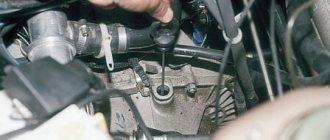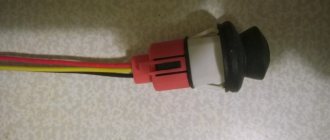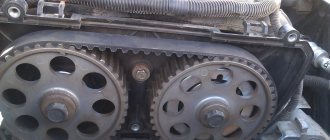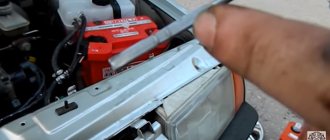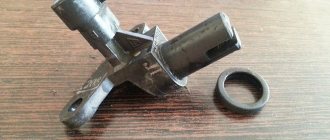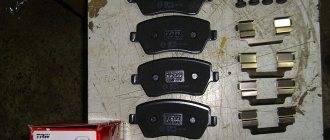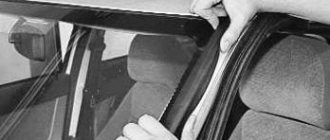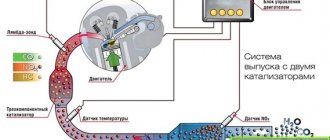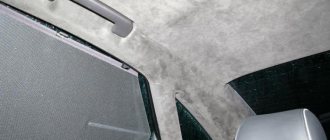Where is the ECU controller located on the Lada Kalina
So, the Kalina engine control unit is located at the very bottom of the console, between the floor and the heating radiator. It is accessible from the passenger's feet.
To do this, you need to remove the plastic cover, which is attached with one screw. We unscrew it and move the lining forward along the direction of the car, after which it should completely disengage. We remove the cover to the side. Below it we see the following picture.
Location of the ECU controller on Lada Kalina
What to do if the block burns out
It happens that a breakdown in Kalina is discovered very late, when the engine practically does not work.
In this case, you can take out the ECU and assess its condition. The key may be broken, or the board may simply be burned out. In the first case, the board can be brought back to life by replacing the key, in the second - only by replacement.
If you are lucky, then the antifreeze did not completely burn the board, but simply prevented the contacts from working properly. In this case, the board must be wiped and dried.
When the ECU is replaced with a similar used part, its firmware will be needed, since the “old” car remains in the memory.
The new part does not require firmware. Specialists can reflash such parts for a fee in the region of 1000-2000 rubles.
Due to design flaws, many Lada Kalina drivers are faced with the problem of a leaking radiator, which causes the ECU to burn out. There is only one way to prevent this - by changing the location of the part. If this is not done, sooner or later after using the oven the control unit will burn out, and then it will have to be completely replaced.
tweet
back Installing a trunk with your own hands on a Kalina sedan
Next How to replace the heater radiator in Lada Kalina?
Tags: transfer, repair, ECU
Why the ECU on the Lada Kalina does not work - the main reasons
One of the most common problems that Lada Kalina owners encounter is ECU failure. Let's look at the main reasons for controller failure:
- Failure due to a short circuit in the on-board network. Here, you can get by with little effort and solder the main resistors, or it will lead to complete combustion of the element.
- If liquid gets on the unit panel, which will lead to complete failure. Usually the ECU is filled with antifreeze.
- Illegal actions of third parties that will lead to ECU failure.
- Other reasons not previously stated.
All these reasons will serve as a reason for diagnosing and dismantling the car control unit.
Let's sum it up
If symptoms appear, the owner of LADA Kalina should contact service as soon as possible, because the cost of repairs can be significantly reduced. It is advisable to independently carry out the procedures we have indicated if the owner of LADA Kalina has a sufficient level of experience in dealing with automotive electronic devices. To do this, at a minimum, you need to know where the ECU is located, as well as how to remove the ECU. However, a 100% positive outcome of the event should not be expected. In case of failure, we recommend contacting the service specialists.
Almost all Lada Kalina owners, especially those who have owned this car for a long time, know about such a problem as flooding the electronic engine control unit (ECU) with antifreeze or other coolant. This problem arises due to the fact that the “Brains” are located in close proximity to the radiator of the stove and if the radiator leaks, the controller floods with coolant and it accordingly fails. If you have not heard about such a disaster, this does not mean that this will not happen to your Kalina. So it is better to move the control unit to a safe place.
After reading a bunch of different topics on forums and blogs about this event, I decided to do the same with my car. Of the methods listed, the following were:
- Move it under the insulation and attach it there, just above the front passenger's carpet
- Attach to the air duct above the barbecue shelf
- Wrap the block with a plastic bag or cover it tightly with sealant (This should not be done under any circumstances, since moisture-condensation will accumulate inside the housing, which will quickly cause combustion)
How to remove the ECU on a Lada Kalina - step-by-step instructions
In order to remove the ECU unit on a Lada Kalina, you must perform the following procedure:
- First you need to unscrew 2 screws, the location of the first is shown by the arrow. The second is at the same level on the engine side. Before doing this, you must remember to remove the terminal from the battery. After unscrewing the screws, do you need to pull the block towards the passenger door? and he must leave from there along the guides. Sometimes it happens that the wires rest against the carpet. Then they need to be corrected.
- In order to remove the connector and disconnect the unit from the wires, you first need to: pull the connector lock to the side. The latch is a bracket. I think you can easily find it on the connector.
Removing the control unit
Using a Phillips screwdriver, unscrew the bolts and remove the plastic casing installed “at the feet” on the front passenger seat.
In order to get the controller, you will have to tinker a little. Unscrew the fastening screw and pull the block towards you, turning from side to side. If that doesn’t work, press it on the driver’s side, having first removed the casing there. Upon completion of the operation, we will get something like this:
After the Kalina ECU is removed from its regular place, we will need to remove the slide on which the unit “sat.” Unscrew them with a screwdriver on both sides.
The ECU on Kalina is filled with antifreeze - what to do?
After the block filled with antifreeze has been removed, its initial inspection should be carried out. For these purposes, it is necessary to remove 4 screws using a star screwdriver. Then you should slowly remove the control board for a visual inspection. The most common failure is the burnout of the ignition coil output switch. In this case, repair will not help.
As a result of such a malfunction, the Lada Kalina starts working on only 2 cylinders, and sometimes refuses to start at all. You can cope with a similar problem in a stationary workshop. There they will remove the damaged element, wash and dry it. The second most common problem is board burnout. It is not difficult to detect such a defect: the characteristic blackening of the board will leave no doubt.
Is it possible to repair the ECU in this case? The answer to this question can only be given by a service center, but experience shows that repairs will not help here. A complete replacement is required. It happens that sometimes the brain circuitry is slightly damaged. If this happens, then the car owner can get off easy. To restore the car to working order, you will need some minor repairs:
- wipe the block with a dry cloth;
- rinse with WD-40 several times and blow it out with a compressor;
- rinse several times in alcohol and blow again with a compressor;
- dry well, otherwise the Lada Kalina will not move;
- drying takes at least 1-2 hours.
Functions and design of the Lada Kalina electronic control unit
A modern car is a high-tech device. Just look under the hood and under the panel: sensors, wires, control units and other electronics are installed everywhere. The more expensive and presentable the car, the more it is stuffed with all kinds of equipment. As a rule, the more electronics there are, the more problems there are with this.
In any car, and the Lada Kalina is no exception, the electronics are controlled by a small box - an electronic control unit, or simply an ECU.
ECU interchangeability on Lada Kalina
I will give a table of interchangeability of Kalina ECU
. This data was not verified by me personally, but by one authoritative master. The interchangeability of these blocks applies only to blocks with factory firmware (that is, after installation there is no need to reflash the block for your engine and sensors). So, in each line there is a block marking, firmware version and toxicity class.
- Bosch 21114-1411020-40 with software B104CR01(02) Euro3 (in my cases it was this one) can be replaced with:
- Bosch 21114-1411020-40 with software B102СQ05(CR06) Euro3;
- Bosch 11183-1411020-02 with software B101CR01(02) Euro2.
There is one peculiarity here. If your car has an air conditioner, then the firmware version must be B104CR02 and no other, otherwise the engine will not compensate for the load from the air conditioner. But since in this article we are talking about a car without it, you can ignore the last 2 digits of the firmware.
All of the above Bosch blocks can be replaced with domestic Janvr7.2 and 7.2+ blocks.
Domestic blocks are all Euro 2, with the exception of M73 blocks - they are Euro3. January 7.2 and 7.2+ blocks manufactured by Avtel or Itelma (Euro2) for Kalina 1.6l 8V: 7.2 11183-1411020-21(22) with software A(I) 201CO56(57)(58); 7.2+ 11183-1411020-21(22) with software A(I)201CP57. These blocks do not support air conditioning, as I understand it. And, in fact, the M73 blocks, which are suitable for Kalina. These units are all Euro 3: M73 21114-1411020-41 with software A303CE05(CF06) Euro3 (support air conditioning); M73 21114-1411020-42 with software I303CE05(CF06) Euro3 (support air conditioning).
Thus, all of the listed ECUs with Euro3 toxicity class can be changed and can be changed among themselves without hesitation (only if they have factory firmware). It is also possible to replace a block with Euro 3 class with a block with Euro 2 class, but vice versa is not possible. All markings are located on a white plate glued to the ECU cover. Next, I consider it necessary to consider the option of replacing the unit with a used one that was installed on a car with an activated immobilizer, since in this case there is one unpleasant feature.
Main malfunctions and their causes
There are not many problems with the ECU. Basically, controller failure occurs due to a power surge in the network. Other possible system problems:
- The device often fails due to mechanical damage. For example, the device received a strong blow or prolonged vibrations were observed, which caused cracks to appear on the soldered contacts and in other places.
- The controller overheats due to strong temperature changes. For example, in winter, some motorists start the engine at high speeds, trying to ensure it starts, which results in overheating of the ECM.
- Corrosion. Oddly enough, rust appears on the module due to frequent changes in air temperature and, as a result, the occurrence of large amounts of condensation.
- Depressurization. For this reason, moisture gets inside, which leads to failure of the device.
- Lack of communication with the control unit. Occurs after interference in the control system from the outside. This often happens when they try to “smoke” another car with a dead battery from one car. It is possible that while the engine is running the battery terminals are reset or the polarity is incorrect when connecting (the terminals are reversed). Less often, lack of communication occurs due to the starter starting without connecting power to it.
If the device fails for some reason, repair or replacement should be carried out only after comprehensive diagnostics have been performed. The nature of the malfunction may indicate problems associated with the functioning of other systems. If they are not corrected in a timely manner, repairing or replacing the module with a new one will lead to repeated failure.
Symptoms of ECU malfunction
If the device is not working correctly or there is no connection at all, then you can notice this by the following signs:
- If there are obvious malfunctions, the Check Engine icon on the instrument panel does not light up or flashes intermittently at varying frequencies. You must first make sure that the light bulb is working properly and that it has power, and only then can you diagnose the ECU module.
- When connecting a diagnostic scanner to the connector, the latter produces incorrect data that raises serious doubts. Simply put, the data is completely different from what it should be. If the controller fails, the scanner may not connect at all.
- Engine malfunctions, tripping, the car does not start or starts with difficulty. However, there are no objective reasons for such phenomena.
- Misfires when the ignition system is in good condition.
- The fan in front of the radiator turns on spontaneously.
- For no apparent reason, fuses burn out, and different ones. Usually fuses blow due to voltage surges in the on-board network or a short circuit in the circuit, but if the diagnostics do not reveal such problems, then the problem is with the ECM.
- Pulses from the sensors do not arrive or arrive, but unevenly.
- Incorrect operation of the gas pedal. This is especially true for the electronic pedal: when the driver presses it, it either does not respond or does so late.
- Damage to the device body or contacts, for example, traces of burning on the terminal blocks.
A malfunction of the controller may be indicated by the absence of control signals for the ignition system, IAC, fuel pump and other devices whose operation is regulated by the electronic control unit.
